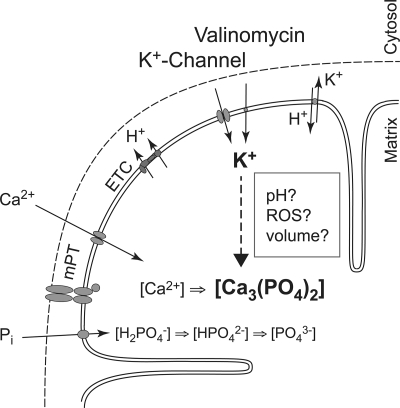FIGURE 4.
How increased K+ conductance may improve mitochondrial calcium retention and sensitivity to permeability transition. Schematic illustrations are shown of some proposed physiological effects caused by increased K+ conductance under conditions where mitochondria buffer an increased cytoplasmic calcium load. Increased K+ conductance by K+ channel activation or by the K+-carrier valinomycin may enhance matrix alkalization via increased H+ extrusion by the electron transport chain (ETC). The uptake of phosphate (Pi) and the equilibrium between differently protonated phosphate groups each depends on pH. An alkaline pH enhances the availability of PO43−, enabling formation of calcium phosphate complexes (e.g. Ca3(PO4)2) from free Ca2+. Enhanced matrix volume due to the osmotic effect of K+ may also lead to increased availability of Pi and enhanced calcium complex formation. The maintenance of low [Ca2+] in the mitochondrial matrix reduces the sensitivity of mPT and may, therefore, increase CRC. Increased K+ conductance has further been suggested to elevate mitochondrial ROS production, which activates PKCϵ and, through its claimed association with the mPT pore complex, induces resistance to mPT (22, 44, 53).

